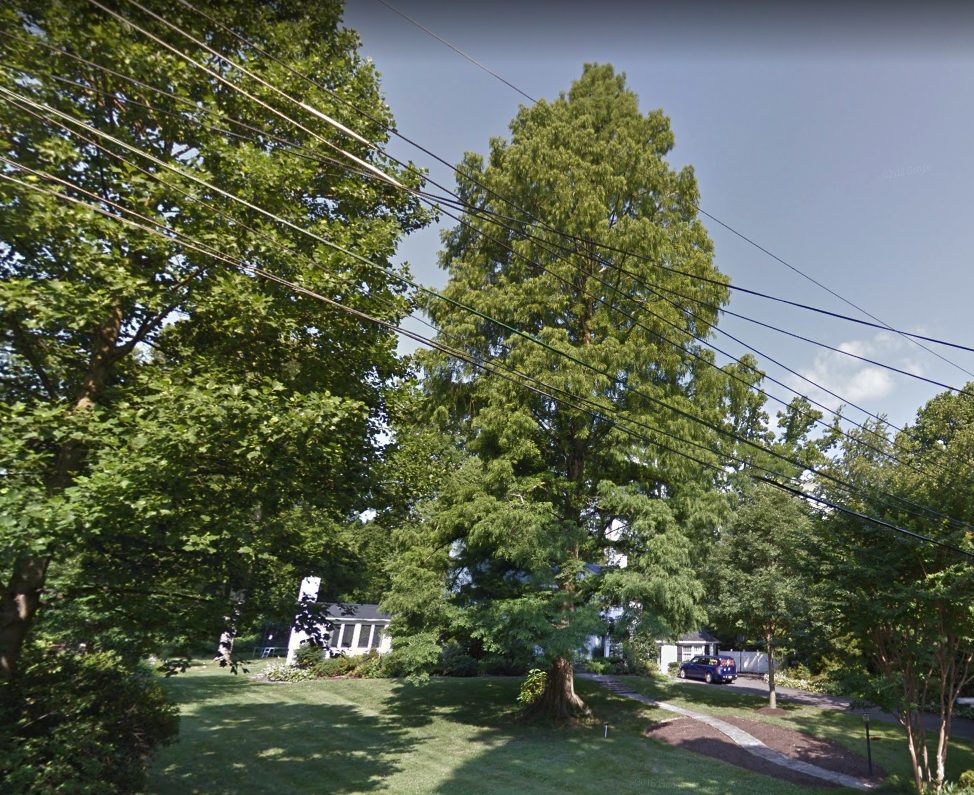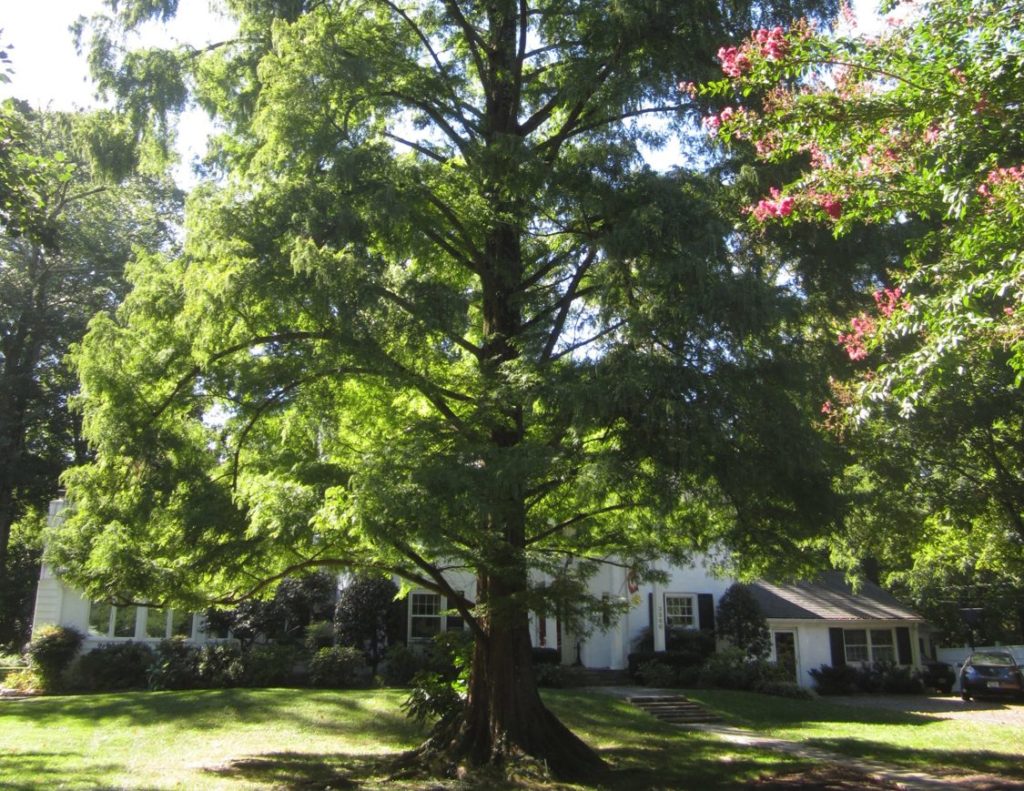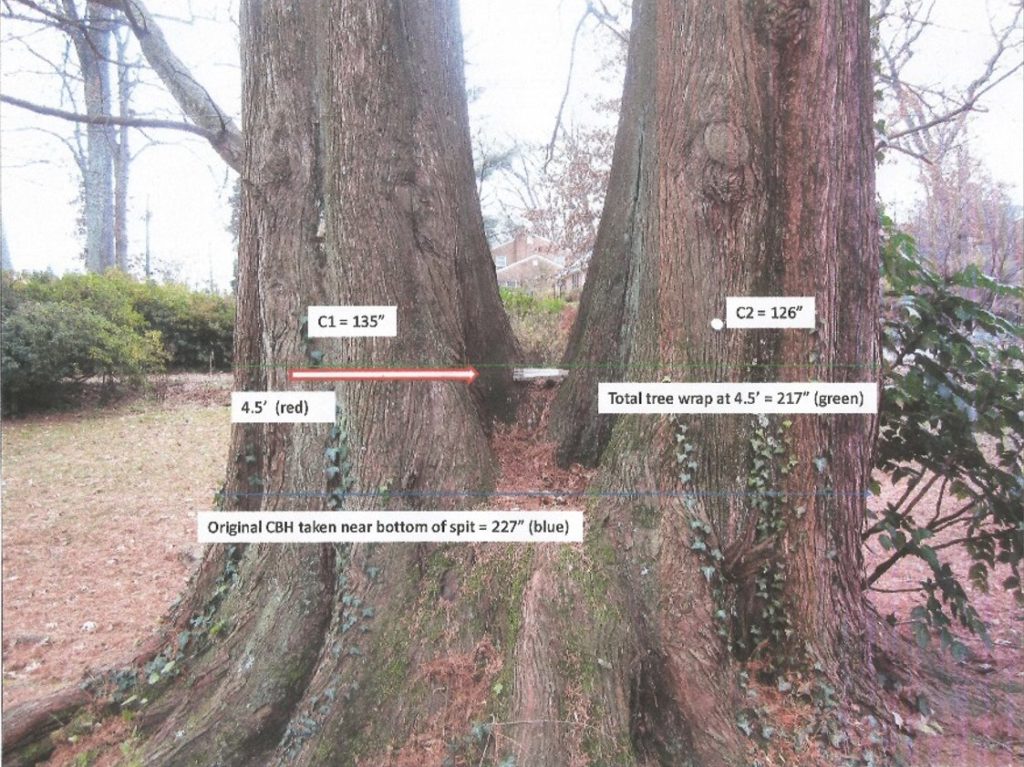Conservationists and neighbors are teaming up to push back against plans to chop down a 114-foot-tall dawn redwood tree in Northwest Arlington.
A developer is currently hoping to demolish a single-family home along the 3200 block of N. Ohio Street, subdivide the lot and build two homes in its place, according to county permit applications.
As part of that process, Richmond Custom Homes could eventually remove several trees in the area, including the large dawn redwood tree in the center of the Williamsburg property.
But an online petition to protect the tree has already garnered more than 800 signatures, and the neighborhood’s civic association is pleading with county leaders to protect the redwood. Not only is the tree recognized as one of the largest of its species by both county and state officials, but it sits within a “Resource Protection Area,” giving the county the chance to scrutinize these construction plans quite closely.
“The tree is stately, thriving and establishes a sense of place and continuity in a rapidly changing county,” Ruth Shearer, the president of the Williamsburg Civic Association, wrote in a letter to the County Board. “The loss of such a prized and recognized tree would be a tragedy, not only to this community but also to Arlington and to Virginia.”
The developer didn’t immediately respond to a request for comment on its plans for the property. But Shearer points out in her letter that county and state law generally prevents the removal of large trees in Resource Protection Areas, zones near streams that feed into the Chesapeake Bay.
She argues that Richmond Custom Homes likely won’t be able to prove that their plans meet the narrow exceptions allowing the removal of trees in these areas, a claim echoed by the advocates with the Arlington Tree Action Group.
“Both this tree and this RPA are important for protecting the air and water quality not just of the immediate neighborhood and Arlington County at large, but of the Bay watershed,” the group wrote in a news release. “The loss of either would call into question the enforcement of the [Chesapeake Bay Protection Ordinance].”
The action group added that this tree is likely one of the largest dawn redwoods in the entire country, and could live to be up to 600 years old if left undisturbed.
Jessica Baxter, a spokeswoman for the county’s Department of Environmental Services, noted that the redwood is not necessarily guaranteed protection under Arlington’s tree ordinance, however. She points out that the tree would need to be designated as a “specimen or heritage tree,” a designation the county can only grant following a request from the property’s owner, and the homeowners have yet to ask for such a change.
“The county is reviewing the [developer’s permit] applications and its options for preserving the tree,” Baxter told ARLnow via email. “We’ll keep the community informed of the outcome.”
Read the entire statement on the redwood from the tree action group, after the jump.
AT RISK: STATE CHAMPION TREE IN RESOURCE PROTECTION AREA
Arlington, Virginia – June 25, 2018. A Commonwealth of Virginia State Champion Tree – very likely one of the oldest Dawn Redwoods in the United States – is at risk of being cut down. As Arlington County acknowledges, the Dawn Redwood is located in a Resource Protection Area (RPA); the Chesapeake Bay Protection Ordinance (CBPO) requires RPAs to be designated near Arlington streams because those waters flow into the Bay. Thus, both this tree and this RPA are important for protecting the air and water quality not just of the immediate neighborhood and Arlington County at large, but of the Bay watershed. Other single-property homes in this RPA have observed the restrictions placed on building in a RPA.
This has the makings of a landmark case. A Champion Tree and the RPA in which it is located are at stake; the loss of either would call into question the enforcement of the CBPO, not to mention the County processes used to designate Champion Trees and RPAs.
This Dawn Redwood, given its size, is likely one of the oldest in this country. It was identified by American Forests, the Virginia Urban Forest Council, the Virginia Forestry Association, and Arlington County as both an Arlington Champion Tree and a State Champion Tree. When last measured by Arlington’s Urban Forester, it was found to be 114 feet high, with a crown of 60 feet and a circumference of 185 inches.
A Resource to Protect
Generally speaking, the removal of large trees (more than 3 inches in diameter) is not permitted in RPAs, although there are exceptions where, for example, the application of the buffer would prevent the achievement of a “minimum buildable area.” The exceptions require the submission of water quality impact assessment data, a tree preservation and protection plan, sediment and erosion control plans, and other materials. The county website describes RPAs as “…stream or wetland buffers [that] help protect water quality by: filtering out pollutants from storm water runoff; reducing the volume of storm water runoff; minimizing erosion, and; providing wildlife habitat. A fully vegetated stream buffer can help protect private property by preventing erosion along a water body. Steep slopes (25 percent or greater) that are adjacent to buffers are also part of the RPA because of the potential for erosion in these areas. In RPAs, existing trees and other vegetation are protected and building projects are regulated to protect water quality.”
The Dawn Redwood lies within the Williamsburg Civic Association (WCA); the WCA 2017 Neighborhood Conservation Plan, like that of many civic associations, identified the loss of mature trees through development as one of the biggest concerns of residents. A key goal of the Civic Association is to promote efforts to stem “the decline in the tree canopy occasioned by residential development and tear-downs.”
The Dawn Redwood is an unusual tree. Throughout most of modern history Dawn Redwoods were known only from the fossil record. The living tree was discovered in China in the early 1940s and seeds were imported into the United States in the late 1940s. The trees are considered endangered in the wild but have adapted to urban settings because of their tolerance for urban air pollution and wet sites. It’s one of the few deciduous evergreens, losing its needles in the fall and replacing them in the spring. They can live up to 600 years.
Neighborhood petition
A petition launched by neighbors recognized that this beautiful, healthy tree is on a lot large enough to keep the tree and build new homes, just set farther back on the lot. The petition quickly garnered nearly 800 signatures. An article in Arlington Connection (6/13/18) quoted a resident who reviewed the notes to the permit database in April and found building in the RPA had been rejected “…because of failure in the grading plan, the water quality impact assessment, the erosion and sediment control plan and the tree preservation and protection plan.”
Civic Association Plea
In a June 22 letter to the Arlington County Board, the President of the Williamsburg Civic Association lamented that razing the tree “will jeopardize important environmental protection goals embodied in the Chesapeake Bay Preservation Act, Arlington’s Chesapeake Bay Preservation Ordinance (Chapter 61), and Arlington’s Stormwater Manual.” Ruth Shearer added that “state and local law generally prohibit the removal of trees in Resource Protection Areas,” and concluded that the “loss of such a prized and recognized tree would be a tragedy, not only to this community, but also to Arlington and to Virginia!”
Dangerous Precedent?
The Champion Dawn Redwood and the RPA in which it stands provide benefits to all residents, including: capturing carbon and purifying the air, filtering water (ending up in the Bay), giving shade and saving energy, supporting wildlife, mitigating climate change (by removing carbon from the air), and adding to the beauty, ambiance, and history of the neighborhood and county. Both deserve protection.




